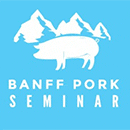 One of the best opportunities for Canada's pork industry to improve meat quality may be to "follow the fat."
One of the best opportunities for Canada's pork industry to improve meat quality may be to "follow the fat."
As consumers move away from carbohydrates and fat takes higher profile, focusing on fat may be one of the strategies to improve meat quality. While it is not likely a good idea to get overly focused on one meat component, there is little doubt fat will present opportunities going forward.

That was one of the messages that Brian Sullivan, of the Canadian Centre for Swine Improvement in Ottawa, Ont. had for delegates to the 2019 Banff Pork Seminar, Jan. 8 to 10 in Banff, Alta.
"People often think of meat as protein," says Sullivan. "When we think of alternatives plant protein comes to mind. But meat is so much more than protein and the search for value may mean looking at different meat components than what we have been in the pork industry."
Human nutrition research shows we need protein in our diets and a deficiency of protein or essential amino acids can lead to serious health problems. But too much protein may not be healthy and at the very least is wasteful.
Research is not so clear when it comes to carbohydrates and fat. Research from about 50 or 60 years ago suggested high fat intake was unhealthy and linking fat intake with risk of cardiovascular disease. This led to massive efforts to produce low fat foods. For its part, the pork industry has done a remarkable job of making pork leaner.
In isolation, we might say that's a good thing. Research suggested too much fat was unhealthy, consumers were looking for leaner products and we delivered, as did the dairy industry and others. However, an unintended consequence of lower fat intake has been a shift to increased consumption of carbohydrates. Although this may not have been the intention, it is a mathematical certainty that if we eat less fat, keep protein intake about the same and take in the same amount of food energy, then we must eat more carbohydrates.
Is this a good thing? Recent research suggests it is in fact a very bad thing, a tragic example of what can happen if we look at something in isolation, in this case taking fat out of the diet. A current research question is, therefore, what happens if we put more fat back into our diets so that we don't need to eat so much carbohydrates. We may find that this is a good thing and we may soon find that consumers want products with more fat, including pork products.
Bigger picture
"Meat quality is certainly not simple, and it is much more than a good source of protein," says Sullivan. "Other components of meat, especially fat, have a big impact on nutritional value, consumer satisfaction, processing and economic value.
"Although it is important not to look at anything in isolation, fat may be the most important component of pork that we should be considering for improvement of meat quality. The money is following the fat if you consider our current markets for pork and if you consider which parts of the hog are most valuable today."
If human diets shift to lower carbohydrates and higher fat, demand for good quality fat sources such as pork will increase. As consumers discover that more fat may be healthier, they will also rediscover that more fat is tastier. This will lead to increased demand and more opportunities for pork cuts with optimal amounts of fat and to ways of preparing food with pork fat rather than throwing the fat away.
Technology is available and emerging that can provide much more information about pork carcass and meat quality than previously available, says Sullivan. And recent investments in applied research on new technologies has positioned Canada's pork producers and packers to enhance the quality and value of pork, which is of course, much more than a good source of protein.
"Understanding markets today, especially the higher value markets, could help us to get more value out of the carcasses that are available today," he says. "It can also guide us on what we might change to make carcasses more valuable in the future.
"Although more challenging, it can also help to develop new markets with higher value and demand. If, for example, consumers in North America wanted to shift to lower carbohydrate and higher fat diets, what kind of pork cuts would be most suitable?"

January 10, 2019 - 2019 Banff Pork Seminar (Meristem Land and Science)




